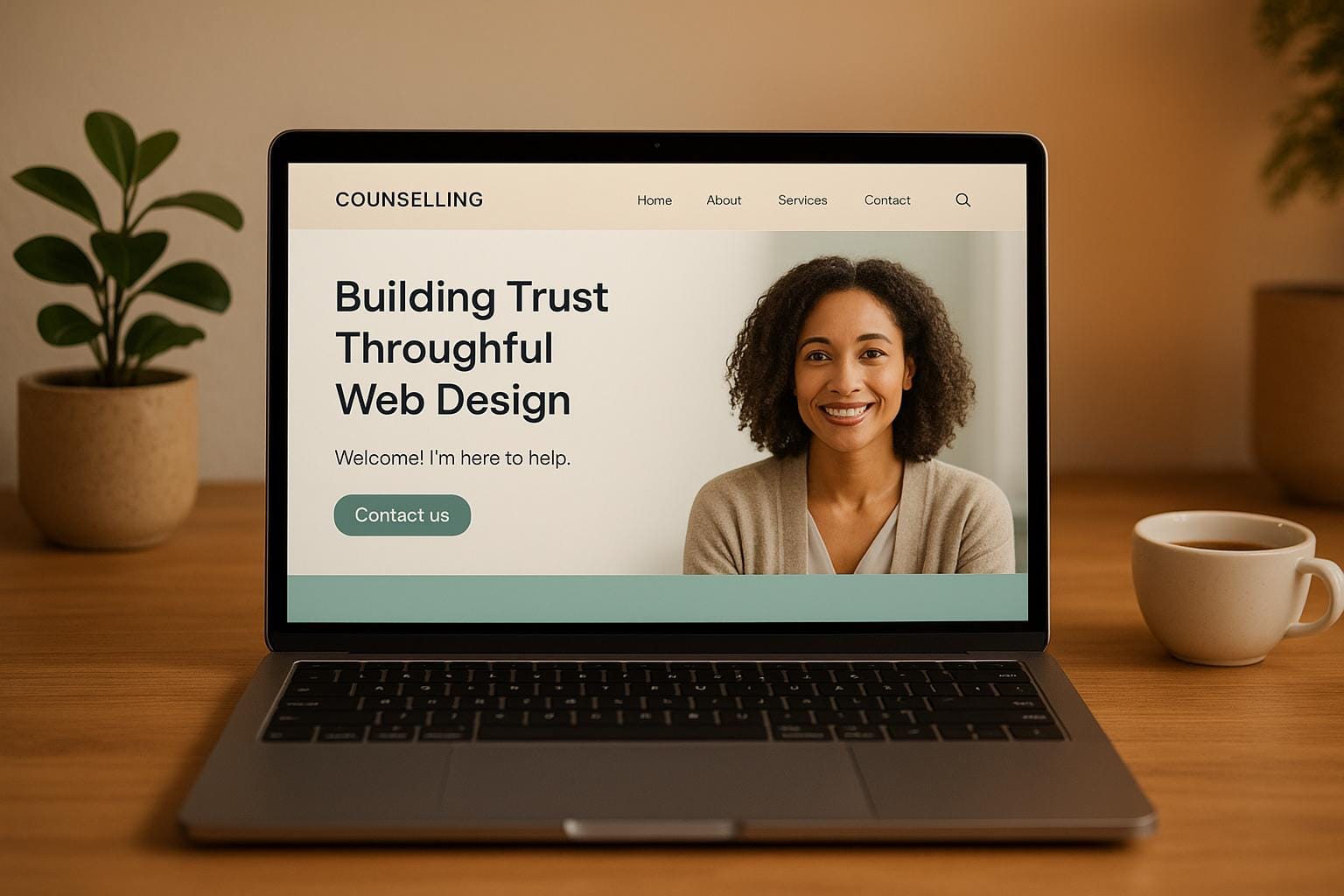A counsellor’s website is often the first step for potential clients seeking help. A well-designed site builds trust, reduces no-shows, and encourages engagement. Here’s how you can create a professional, welcoming, and secure online presence:
- Prioritise Trust: Highlight credentials, client testimonials, and clear privacy policies.
- User-Friendly Design: Ensure mobile compatibility, simple navigation, and accessible booking.
- Legal Compliance: Follow UK GDPR and accessibility standards like WCAG 2.2.
- Calming Aesthetics: Use soothing colours (e.g., blues, greens) and professional imagery.
- Showcase Services Clearly: Provide transparent pricing, service details, and FAQs.
- Secure Data: Implement SSL encryption and robust security measures.
A thoughtful design reflects professionalism and empathy, making it easier for clients to take the first step towards therapy.
4 Counseling & Therapist Website Examples & 5 Elements to Include on Your Counseling Website
Core Elements of Trust-Building Web Design
Establishing trust online hinges on creating a website that feels welcoming, professional, and reliable. Did you know that 75% of a website’s credibility is tied to its design, and 94% of first impressions are design-related? [3]. That’s why getting your web design right is so important.
Meeting Client Expectations
To connect with potential clients, it’s crucial to understand what they’re looking for. A design that is professional yet approachable can make visitors feel at ease and encourage them to take the next step.
Here are some essentials to include:
- Clear Service Information: Make your areas of expertise and therapeutic approaches easy to find.
- Transparent Pricing: Clearly display session costs in £ and outline accepted payment methods.
- Accessible Booking: Provide simple, user-friendly appointment scheduling options.
- Mobile-Friendly Design: With 59% of visitors accessing websites via mobile devices, your site needs to work seamlessly on smartphones [2].
UK Legal and Access Requirements
Meeting legal and accessibility standards in the UK is not just about compliance – it’s about fostering trust and inclusivity. Here’s a breakdown of what’s needed:
| Requirement | Key Elements | Impact |
|---|---|---|
| GDPR Compliance | Privacy policies, cookie consent, data protection measures | Builds trust by showing you handle data responsibly. |
| Equality Act 2010 | Accessibility features, reasonable adjustments | Ensures inclusivity for the 1 in 5 UK residents with disabilities [4]. |
| WCAG 2.2 Standards | Alternative text, keyboard navigation, colour contrast | Makes your site usable for everyone, regardless of ability. |
"The first question in the minds of many of your website visitors is whether or not you work with the specific struggle they are having." – Sarah Gershone, Owner of Strong Roots Web Design [2]
Design Elements That Build Trust
Your website’s visual and functional aspects are the first things people notice. Thoughtful design choices can make a lasting impression and encourage engagement.
Colour and Visual Style:
- Opt for calming colours like blues and greens.
- Use imagery inspired by nature to create a soothing effect.
- Keep branding consistent across the site.
- Ensure there’s enough contrast to make text easy to read.
Professional Details:
- Highlight your credentials prominently.
- Use high-quality, professional headshots.
- Feature client testimonials (with their permission).
- Secure your site with HTTPS encryption to protect user data.
Navigation and Structure:
- Simplify your menu with 3–4 main categories.
- Place contact information where it’s easy to find.
- Add clear, actionable buttons to guide visitors.
These elements create a solid foundation for designing a website that inspires trust and confidence in your clients.
Design Tips for Counsellor Websites
38% of visitors stop engaging with a website if its layout feels unattractive [7]. These practical tips build on earlier trust factors to help you create a professional and inviting online presence.
Using Colours and Space
The right use of colours and space can set the tone for your website. Many wellness websites rely on colour psychology to evoke specific emotions:
| Colour Scheme | Psychology | Example Implementation |
|---|---|---|
| Blues & Greens | Calming, trustworthy | Zendesk uses various shades of blue and green to convey reliability [6] |
| Soft Neutrals | Professional, welcoming | Work Responsibly features understated tones with green accents for readability [6] |
| White Space | Clean, organised | Evernote effectively uses white space with green call-to-action elements [6] |
Avoid overcrowding your website by ensuring plenty of spacing. A clean layout makes it easier for visitors to focus on key information.
Displaying Credentials and Reviews
Trust indicators play a crucial role in turning visitors into clients. In fact, 72% of consumers feel more confident about a business after reading positive testimonials [8]. Incorporate these elements to strengthen trust:
- Add accreditation logos from recognised UK counselling bodies prominently on your site.
- Include testimonials that highlight positive outcomes while respecting client confidentiality.
- Showcase your certifications and details about your ongoing professional development.
"Trust is like a bank account – you need to make regular deposits through consistent positive interactions before you can afford to make any withdrawals."
– Ernesto Pramasetya, co-founder at GiantFocal [9]
Choosing the Right Images
Images are another powerful tool to enhance your website’s credibility and appeal. Here’s how to use them effectively:
- Feature high-quality headshots and calming environmental photos to create a warm, approachable feel.
- Use diverse imagery that reflects the variety of your client base, ensuring visitors feel represented and included.
Together, these visual and design elements create a welcoming atmosphere that encourages potential clients to take the next step in their therapeutic journey.
sbb-itb-18064a9
Content Layout for Better Engagement
Beyond trust-building design and clear service information, the way your website’s content is organised plays a big role in keeping visitors engaged. A well-structured layout ensures that potential clients can quickly find what they need, making them feel more confident about your counselling services. Studies indicate that a thoughtfully designed site can significantly boost both engagement and trust [10].
Writing Clear Service Pages
Service pages should focus on addressing the needs of your clients rather than simply listing what you offer. Here’s a practical way to structure these pages:
| Page Element | Purpose | Example Implementation |
|---|---|---|
| Problem Statement | Clearly define the challenges clients face | Soul Care‘s family counselling page discusses common relationship issues [11] |
| Solution Overview | Explain your therapeutic approach | Gavett Burch’s "Meet Your Therapist" section details treatment methods [11] |
| Value Proposition | Highlight the outcomes clients can expect | The Wellness emphasises creating a "safe place to be heard" [11] |
Be sure to include pricing and insurance information to maintain transparency and build trust.
Improving User Experience
Clear, well-organised service pages are the foundation of a positive user experience. To keep visitors engaged, consider adding the following elements:
- Resource Library: Kar’en Hearts Counselling Service does an excellent job of organising educational materials on therapy approaches and prevention strategies [1].
- Blog Section: Therapeutic Conversations keeps an active blog that covers mental health topics, showcasing expertise and providing helpful insights [1].
- FAQ Section: Address common client concerns with a dedicated FAQ section [1].
Additionally, integrating a secure and accessible online booking system can enhance the overall experience for your clients.
Setting Up Online Booking
A secure, user-friendly booking system is essential for protecting client privacy while simplifying the appointment process. Defiance Counselling‘s appointment request form is a great example of best practices. It includes:
- Clear availability windows
- Requests for only necessary information
- Automated confirmation messages
- Privacy policy details
Your booking system should integrate smoothly with your practice management software while meeting data protection standards. This ensures both convenience and security for your clients.
Technical Tools for Better Security
Strong security measures not only protect client data but also build trust with your audience.
Website Security Basics
Start with the essentials: an SSL certificate and data encryption. The Information Commissioner’s Office (ICO) highlights the importance of secure data handling: "The UK GDPR says you must implement appropriate technical and organisational measures to process personal information securely" [15].
Here are some core security features to consider:
| Security Feature | Purpose | Implementation |
|---|---|---|
| SSL Certificate | Encrypts data | Displays a padlock icon and ensures encrypted data |
| GDPR Compliance | Protects personal data | Use consent forms, privacy notices, and secure storage |
| Regular Audits | Identifies vulnerabilities | Perform security assessments and have breach plans ready |
| Access Controls | Manages user access | Implement role-based permissions for user access |
Must-Have WordPress Plugins
Choosing the right security plugins is essential for safeguarding your counselling website. One standout option is All-In-One Security (AIOS), which boasts a "5-star user rating across more than 1 million installs" [12]. Below are a few key plugins to consider:
| Plugin Name | Annual Cost | Key Features |
|---|---|---|
| All-In-One Security | £55 | Auditing, monitoring, and firewall protection |
| MalCare | £79 | Malware scanning and one-click removal |
| iThemes Security | £79 | Login protection and pre-set security templates |
A case study from 2024 revealed that a major online retailer saw a 40% increase in repeat customers after implementing end-to-end encryption, demonstrating the impact of enhanced trust [13].
While desktop security is crucial, extending these measures to mobile platforms is equally important for a comprehensive approach.
Mobile Design and Search Rankings
With the majority of users accessing websites via smartphones, ensuring mobile security is non-negotiable. Google now factors SSL into search rankings, meaning secure websites are more likely to rank higher [14]. To optimise mobile security and performance, focus on the following:
- Responsive Design: Make sure your security features work seamlessly across all devices.
- Local SEO: Use structured data to boost visibility in local search results.
- Loading Speed: Configure security plugins to maintain quick load times on mobile.
"Given the sensitive nature of the data that you hold and may need to send in emails, it’s best to have available an encrypted email solution for sending sensitive personal information" [16].
Conclusion: Creating a Professional Online Presence
A counselling website that exudes reliability blends appealing design, intuitive functionality, and strong security measures. With telehealth services becoming an integral part of mental healthcare [20], having a well-crafted online presence is no longer optional – it’s essential.
A professional website not only builds credibility but also creates a welcoming space for potential clients while streamlining administrative processes. The design of your site plays a pivotal role in shaping how clients view your services. As Monica Kovach aptly puts it: "When people see an impersonal, outdated, or difficult-to-navigate website, they might equate that with how therapy would be with that person" [5].
Beyond aesthetics, functionality is key to earning client trust. With nearly 60% of users browsing websites on mobile devices, ensuring your site works seamlessly across all platforms is a must [18]. Here are some essential elements to consider:
| Element | Purpose | Impact |
|---|---|---|
| Professional Design | Creates a strong first impression | Builds visitor trust |
| Mobile Optimisation | Ensures accessibility | Improves user experience |
| Security Features | Protects client data | Strengthens long-term trust |
| Clear Navigation | Simplifies the user journey | Boosts user retention |
Together, these features create a cohesive online experience that not only draws in potential clients but also encourages them to stay. As John Garewal from Verum Design explains: "A well-designed therapist website can help you reach a wider audience, establish credibility, and streamline administrative tasks" [17].
"By providing clear and comprehensive answers to common questions about therapy, a robust and inclusive FAQ section helps build trust and transparency – making it more likely that your ideal client will reach out." – Ashley Darnall, LCSW [2]
Attention to these details lays the groundwork for an effective counselling website. With visitors spending an average of 2–4 minutes on a well-designed site [19], it’s crucial to focus on clarity, accessibility, and professionalism. Use thoughtful imagery and carefully chosen colour schemes to create an inviting atmosphere, while adhering to the design and security principles outlined in this guide.
FAQs
How can counsellors ensure their website complies with UK GDPR and accessibility standards?
To meet UK GDPR requirements, counsellors need to have a clear and transparent privacy policy in place. This policy should outline how client data is collected, stored, and used. It’s also essential to obtain explicit consent for cookies and any data processing activities. Clients must be given a straightforward way to withdraw their consent if they choose to. Additionally, regularly reviewing data handling practices ensures ongoing compliance with the regulations.
When it comes to accessibility, websites should adhere to the Web Content Accessibility Guidelines (WCAG) 2.2 AA standards. This involves making the site accessible to users with disabilities. Key measures include offering text alternatives for images, enabling navigation via keyboard, and using high-contrast text for better readability. These efforts not only support inclusivity but also enhance the professionalism of your online presence.
What design features make a counsellor’s website feel trustworthy and professional?
To design a professional and welcoming website for counsellors, start by ensuring clear navigation so visitors can easily find the information they need. Use soothing colours paired with easy-to-read fonts to create a calming and approachable atmosphere. An About page featuring your credentials and a professional photo helps establish trust and credibility. Make sure your contact information is prominently displayed on every page, making it simple for potential clients to get in touch.
Focus on client-centred content that speaks directly to common concerns or questions your audience might have. Including testimonials from previous clients can further enhance your credibility. To build confidence in your website’s security, include clear privacy policies that reassure visitors about data protection. Ensure the site is mobile-friendly, so it’s accessible on all devices. Lastly, encourage engagement by adding a strong call to action, such as a ‘Book Now’ button, to guide visitors towards taking the next step.
Why is mobile optimisation essential for a counsellor’s website, and how does it impact client experience?
Mobile optimisation is crucial for a counsellor’s website, especially since most online searches now happen on mobile devices. When your site is easy to navigate on a phone or tablet, potential clients can quickly find the information they need and book appointments without any hassle. This smooth experience leaves a strong first impression and helps build trust.
A mobile-friendly website brings several benefits: faster loading times, straightforward navigation, and better accessibility. These factors not only improve the user experience but also boost your visibility in search engines. Platforms like Google prioritise mobile-optimised sites in search rankings, giving you an edge in reaching more clients and standing out in a competitive field.


